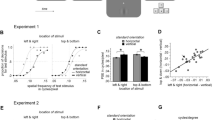Abstract
QUANTITATIVE studies of vision in patients with cerebral lesions pose a challenge to purely topographical concepts of cerebral organisation. Pyschophysical measurements of the detectability of sinusoidal gratings (contrast sensitivity functions)1 established that in the majority of patients detection of high spatial frequencies suffers most. The spatial frequency of a grating is the number of its alternating bars subtended in 1° of visual angle; the higher the number, the finer the pattern. There seems to be no obvious correlation between this loss of fine pattern discrimination and the aetiology or the exact localisation of a cerebral lesion. The neural basis of this loss is unknown in vision as with the other senses. Is it the result of specific vulnerability of those neurones of the primary visual pathways which are optimally responding to high spatial frequencies or to some defect of high order cognitive functions? In this report I present data on three patients who recovered from cerebral blindness. Serial evoked potentials and psychophysical detection of gratings of high frequency showed concurrent changes throughout recovery in one patient in whom they could be measured. This suggests that structures of the central nervous system which determine evoked potentials and psychophysical responses to high frequency gratings are either identical or similarly vulnerable. These data also suggest why mid- and high-spatial frequency channels of the primary visual pathways may be especially vulnerable to cerebral lesions.
Similar content being viewed by others
References
Bodis-Wollner, I., Science, 178, 769–771 (1972).
Campbell, F. W., Cooper, G. F., and Enroth-Cugell, C., J. Physiol., Lond., 203, 223–235 (1969).
Maffei, L., and Fiorentini, A., Vision Res., 13, 1255–1267 (1973).
Glezer, V. D., Ivanoff, V. A., and Tscherbach, T. A., Vision Res., 13, 1875–1904 (1973).
Blakemore, C., and Campbell, F. W., J. Physiol., Lond., 203, 237–260 (1969).
Pollen, D. A., and Ronner, S. F., J. Physiol., Lond., 245, 667–697 (1975).
Campbell, F. W., and Robson, J. G., J. Physiol., Lond., 197, 551–566 (1968).
Campbell, F. W., and Maffei, L., J. Physiol., Lond., 207, 635–652 (1970).
Campbell, F. W., and Kulikowski, J., J. Physiol., Lond., 222, 345–356 (1972).
Bodis-Wollner, I., Hendley, C., and Kulikowski, J., Perception, 1, 341–349 (1972).
Bodis-Wollner, I., Hendley, C., and Atkin, A., in Cerebral Evoked Potentials in Man (edit. by Desmedt, J. E.) (Oxford University Press, London, in the press).
Campbell, F. W., and Green, D. C., J. Physiol. Lond., 181, 576–593 (1965).
Kelly, D. H., J. opt. Soc. Am., 59, 1361–1370 (1969).
Cragg, B. G., Vision Res., 9 733–747 (1969).
Zeki, S. M., Brain Res., 28, 338–340 (1971).
Zeki, S. M., J. Physiol., Lond., 236, 549–573 (1974).
Lindenberg, R., and Smith, J. L., in Neuro-ophthalmology, 2 (edit. by Smith, J. L.), 137–166 (C. V. Mosby Company, St Louis, 1965).
Hoyt, W. F., and Walsh, F. B., Archs Ophthal., 60, 1061–1069 (1959).
Ikeda, H., and Wright, M. J., Vision Res., 14, 133–136 (1974).
Kirby, A. W., Society of Neuroscience, Abstract, 166 (1975).
Daniels, J. D., and Pettigrew, J. D., Brain Res., 93, 41–62 (1975).
Author information
Authors and Affiliations
Rights and permissions
About this article
Cite this article
BODIS-WOLLNER, I. Vulnerability of spatial frequency channels in cerebral lesions. Nature 261, 309–311 (1976). https://doi.org/10.1038/261309a0
Received:
Accepted:
Published:
Issue Date:
DOI: https://doi.org/10.1038/261309a0
- Springer Nature Limited




